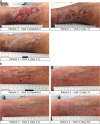The Management of Critically Colonized and Locally Infected Leg Ulcers with an Acid-Oxidizing Solution: A Pilot Study
- PMID: 29561341
- PMCID: PMC5895123
- DOI: 10.1097/01.ASW.0000530687.23867.bd
The Management of Critically Colonized and Locally Infected Leg Ulcers with an Acid-Oxidizing Solution: A Pilot Study
Abstract
Objective: Critical colonization or local infection is very common in chronic wounds, but clinically problematic. Because therapeutic options for these conditions are limited in number and efficacy, the study authors tested a new acid-oxidizing solution (AOS [Nexodyn]; APR Applied Pharma Research S.A., Balerna, Switzerland) to determine its ancillary antimicrobial properties and potential support for wound healing.
Design and setting: This open-label clinical case series was conducted with a prospective, single-arm design at the Federal County Hospital in Bregenz, Austria.
Patients: In the study, 30 patients with critically colonized or locally infected chronic leg ulcers of any origin were included.
Interventions: The AOS was applied on each leg ulcer at every dressing change for 35 days.
Main outcome measures: The tolerability and performance of the AOS were assessed by evaluating the ulcer characteristics and comparing them with those at baseline. The clinical course of wounds was analyzed using standard measures for bioburden, local infection, pain, pH, and wound healing.
Main results: Application of the solution was well tolerated, and no adverse events were recorded. In all patients, local infection was overcome, and wound bed pH and wound area decreased significantly. In addition, patient pain levels decreased to a level where interventions were not required after study day 7. In 37% of all patients, a complete resolution of chronic ulcers was achieved by the end of the study period.
Conclusion: According to these results, the AOS seems to be a valid and highly tolerable treatment to support wound healing in locally infected ulcers. Nevertheless, larger controlled cohort studies are needed to substantiate these findings.
Conflict of interest statement
The other authors declare that they have no conflicts of interest.
Figures






Similar articles
-
Management of hard-to-heal leg ulcers with an acid-oxidising solution versus standard of care: the MACAN study.J Wound Care. 2021 Sep 2;30(9):694-704. doi: 10.12968/jowc.2021.30.9.694. J Wound Care. 2021. PMID: 34554831 Clinical Trial.
-
Phase IIa randomized, placebo-controlled study of antimicrobial photodynamic therapy in bacterially colonized, chronic leg ulcers and diabetic foot ulcers: a new approach to antimicrobial therapy.Br J Dermatol. 2013 Mar;168(3):617-24. doi: 10.1111/bjd.12098. Epub 2013 Jan 18. Br J Dermatol. 2013. PMID: 23066973 Clinical Trial.
-
Systematic reviews of wound care management: (3) antimicrobial agents for chronic wounds; (4) diabetic foot ulceration.Health Technol Assess. 2000;4(21):1-237. Health Technol Assess. 2000. PMID: 11074391 Review.
-
Topical application of the bee hive protectant propolis is well tolerated and improves human diabetic foot ulcer healing in a prospective feasibility study.J Diabetes Complications. 2014 Nov-Dec;28(6):850-7. doi: 10.1016/j.jdiacomp.2014.07.012. Epub 2014 Aug 7. J Diabetes Complications. 2014. PMID: 25239451 Clinical Trial.
-
[Management of leg ulcers].Rev Prat. 2010 Sep 20;60(7):970-8. Rev Prat. 2010. PMID: 21033497 Review. French.
Cited by
-
Efficacy of an Acid-Oxidizing Solution against Mycobacterium ulcerans.Antimicrob Agents Chemother. 2022 Jan 18;66(1):e0087021. doi: 10.1128/AAC.00870-21. Epub 2021 Oct 18. Antimicrob Agents Chemother. 2022. PMID: 34662181 Free PMC article.
-
The impact of topical agents and dressing on pH and temperature on wound healing: A systematic, narrative review.Int Wound J. 2022 Oct;19(6):1397-1408. doi: 10.1111/iwj.13733. Epub 2021 Dec 20. Int Wound J. 2022. PMID: 34931445 Free PMC article. Review.
-
Are Antimicrobial Peptide Dendrimers an Escape from ESKAPE?Adv Wound Care (New Rochelle). 2020 May 19;9(7):378-95. doi: 10.1089/wound.2019.1113. Online ahead of print. Adv Wound Care (New Rochelle). 2020. PMID: 32320368 Free PMC article.
-
Chronic wounds treated with cold atmospheric plasmajet versus best practice wound dressings: a multicenter, randomized, non-inferiority trial.Sci Rep. 2022 Mar 7;12(1):3645. doi: 10.1038/s41598-022-07333-x. Sci Rep. 2022. PMID: 35256635 Free PMC article. Clinical Trial.
-
Microbiological Status of Venous Leg Ulcers and Its Predictors: A Single-Center Cross-Sectional Study.Int J Environ Res Public Health. 2021 Dec 8;18(24):12965. doi: 10.3390/ijerph182412965. Int J Environ Res Public Health. 2021. PMID: 34948575 Free PMC article.
References
-
- Valencia IC, Falabella A, Kirsner RS, Eaglstein WH. Chronic venous insufficiency and venous leg ulceration. J Am Acad Dermatol 2001;44(3):401-21. - PubMed
-
- Richmond NA, Maderal AD, Vivas AC. Evidence-based management of common chronic lower extremity ulcers. Dermatol Ther 2013;26(3):187-96. - PubMed
-
- Rayner R, Carville K, Keaton J, Prentice J, Santamaria N. Leg ulcers: atypical presentations and associated comorbidities. Wound Pract Res 2009;17(4):168-85.
-
- Agale SV. Chronic leg ulcers: epidemiology, aetiopathogenesis, and management. Ulcers 2013;2013:1-9.
MeSH terms
Substances
LinkOut - more resources
Full Text Sources
Other Literature Sources
Medical
Miscellaneous

